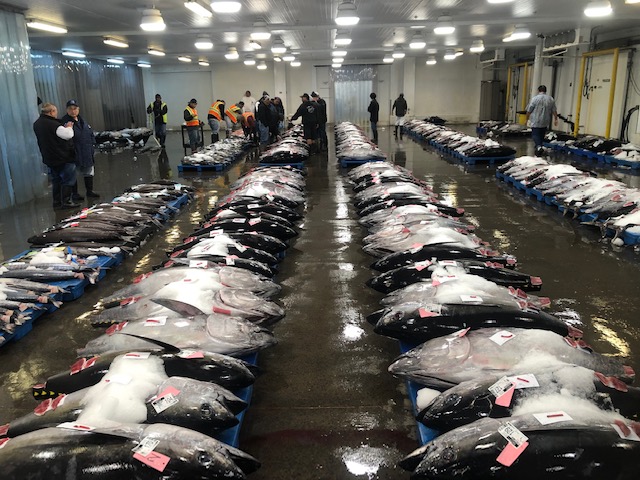The Hawaii Longline Association’s swordfish, bigeye and yellowfin tuna fishery has been certified for sustainable fishing practices by the Marine Stewardship Council, the international nonprofit group whose blue eco-label is sought by seafood retailers and consumers.
The longline fleet is the first Hawaii fishery to enter the MSC program for assessing “if a fishery is well-managed, and reflects the most up-to-date understanding of internationally accepted fisheries science and management,” according to a statement from the council announcing the certification.
The fishery was examined in a 16-month review carried out by a third-party assessment body, the Control Union UK Limited. Under the MSC Fisheries Standard, any fishery must meet three core principles: Sustainable fish stocks, minimized environmental impact, and effective fisheries management. The MSC certification process ensures that seafood products can be traced to a MSC certified fishery through required recordkeeping.
The assessment covered two separate components of the HLA longline fishery: a shallow-set swordfish longline fishery, and the deep-set tuna longline fishery.
The fleet includes 142 locally owned vessels. The shallow-set fishery targets swordfish at night, while the deep-set fishery targets bigeye tuna during the day.
Required observer coverage is 100 percent for shallow-set trips, and at least 20 percent for deep-set trips.
The Hawaii longline fishery dates to 1917, when it was established by Japanese immigrant fishermen. Today, it is the largest food producing industry in Hawaii, with unique cultural, nutritional, and economic importance in a state whose residents consume twice as much seafood per capita as the rest of the country.
The fishery is low volume and high value — with landings worth approximately $125 million annually — making Honolulu one of the nation’s most valuable commercial fishing ports year after year. Some 80 percent of landings are consumed locally in Hawaii, and nearly 100 percent stay within U.S. markets.
Overall, the fishery produces 95 percent of the nation’s bigeye tuna landings, and 50 to 60 percent of swordfish and yellowfin tuna landings.
The Hawaii Longline Association sought MSC certification as part of a continuing commitment to best management practices. In 2021 the fleet voluntarily switched from using wire leaders on their gear to monofilament leaders to promote shark conservation. Approximately 85% of the fleet’s fishing effort occurs on the high seas adjacent to the Hawaii archipelago, with the remainder of fishing effort in US exclusive economic zone Pacific waters.
The fishery is managed and regulated by the Western Pacific Regional Fishery Management Council and the National Marine Fisheries Service.
“The fishery is a recognized global leader in the development and implementation of effective bycatch mitigation practices for sharks, seabirds, marine mammals, and sea turtles,” according to the MSC. “The fishery also pioneered the use of satellite-based vessel monitoring systems in the late 1980s to spatially track fishing locations in near real time. High levels of independent observer coverage have been instituted in the fleet since the early 1990s.”
“HLA is proud to receive the certification as it is recognition of the fleet’s stringent management and monitoring regime. We believe our fleet produces the best quality and highest level of monitored tuna in the world,” said Eric Kingma, the longline association’s executive director. “We look forward to working with MSC, WPRFMC, NMFS and others on the continued and long-term production of sustainably and responsibly harvested fish landed by our fleet.”
An important component of the fishery is the Honolulu Fish Auction, which is the only daily tuna auction in the United States. Celebrating its 70th year in business in 2022, the auction plays a key role in promoting the best quality and highest market value of fish landed by the Hawaii longline fleet.
“All of the Hawaii-based longline fleet offloads at one location in Honolulu Harbor and the auction is the central hub for the supply of fish throughout Hawaii,” said auction manager Mike Goto. “Several companies that buy fish through the auction system will be competing for MSC certified fish and they will distribute that fresh, premium fish to Hawaii and U.S. mainland consumers.”
Hawaii Seafood Council program manager John Kaneko said the new MSC certification willd provide “market validation of the sustainability of Hawaii bigeye tuna, yellowfin tuna and swordfish.
“Sustainability is the result of strict US fishery management under the WPRFMC and NMFS process. Hawaii’s longline fishery is now over 100 years old and counting. Now that’s what I call sustainable,” said Kaneko. “Local seafood is vital to Hawaii’s diverse ethnic communities. It is essential to island culture, traditions, quality of life and Hawaii’s growing reputation as a food tourism destination.”
Nicole Condon, the Marine Stewardship Council’s U.S. program director, said: “the fishery has demonstrated that they’ve put in the hard work to ensure fishing is done in an environmentally sustainable manner, supporting both future generations and our oceans. As someone who lived in Oahu for several years, I’m thrilled to personally welcome the first fishery from Hawaii into the program.”







